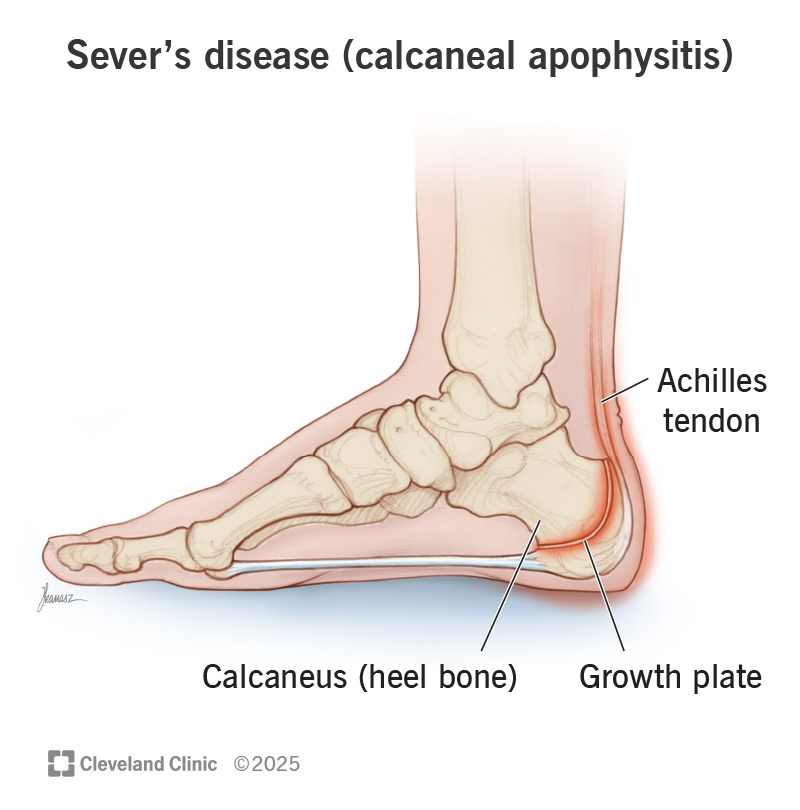Sever’s disease (calcaneal apophysitis) is a type of repetitive strain injury in your child’s heel. Too much strain from activities on their feet causes inflammation in the bone. Your child’s bones are softer when they’re growing, so they’re easier to injure. They’ll need to back off of activities that put stress on their heel until the condition improves.
Advertisement
Cleveland Clinic is a non-profit academic medical center. Advertising on our site helps support our mission. We do not endorse non-Cleveland Clinic products or services. Policy

Sever’s disease is a common cause of heel pain in children, especially active ones. Despite the name, it’s really more of an injury than a disease. Calcaneal apophysitis (CAL-ca-NEEL a-PO-fi-SITE-us) is the clinical term. It means that your kid has inflammation in their heel bone (calcaneus) from putting frequent stress on it during activity. It’s a type of repetitive stress injury, and it heals with time and rest.
Advertisement
Cleveland Clinic is a non-profit academic medical center. Advertising on our site helps support our mission. We do not endorse non-Cleveland Clinic products or services. Policy
Sever’s disease affects children because their bones are softer at the ends where they’re growing (at the growth plate). New bone growth is made of cartilage, which is weaker and easier to injure. As children age, the cartilage hardens into bone. Apophysitis is inflammation of the growth plate of a bone in children. It’s very common — especially between ages 8 and 14, when growth spurts often happen.
Symptoms of Sever’s disease include:
Like other repetitive strain injuries, calcaneal apophysitis happens gradually rather than all at once. It happens when frequent stress on your child’s heel starts to wear it down. This triggers inflammation, which causes pain and swelling. A tight Achilles tendon often contributes to Sever’s disease by pulling on the heel bone when it flexes. The tendon might be tight because bones can grow faster than tendons.
Inflammation is a healing process — it’s how our bodies repair injuries. But it needs time to do its work. If the stress on your child’s heel continues, the inflammation will also continue. Sometimes, the stress is just from normal walking, and there’s no practical way to avoid it. In other cases, practicing high-impact sports on hard surfaces may have contributed to Sever’s disease. Taking a break from them might help.
Advertisement
Other factors that may contribute include:
Doctors diagnose Sever’s disease with a physical exam. Your child’s doctor will apply gentle pressure to their heel and foot to determine where the pain is coming from. They might ask them to walk, run or jump. In some cases, they might order imaging tests, like X-rays or MRI, to help rule out other conditions. (For example, sometimes repetitive stress on your heel bone can cause a stress fracture.)
Treatments for Sever’s disease include:
With rest and a chance to recover, the pain and inflammation in your child’s heel should soon begin to improve. Most kids can return to their former activities in a few weeks to months. Your healthcare provider can give you more specific guidance. If you can’t reduce the stress on your child’s heel, Sever’s disease may last until their bones are finished growing. This process is usually complete by age 15.
If your child has recovered from Sever’s disease and is ready to return to activities, you might want to take some precautions to protect their heels going forward. Your healthcare provider might suggest:
Sever’s disease isn’t serious, and it won’t cause lasting issues for your child. But it can be quite painful while it lasts. If your child is showing Sever’s disease symptoms, schedule a consultation with their healthcare provider right away. Prompt diagnosis and treatment can help reduce their inflammation faster. That means they’ll be back on their feet sooner — and back to doing what they enjoy.
Advertisement
As your child grows, you need healthcare providers by your side to guide you through each step. Cleveland Clinic Children’s is there with care you can trust.

Last reviewed on 03/26/2025.
Learn more about the Health Library and our editorial process.